Search results for: 'can li'
- Related search terms
- can
- can sew
- cann
- Can I
- can i drive on the day
-
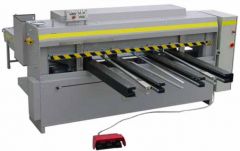 TT-1162 FILLMATIC FU 200/24 UNIVERSAL FILLING MACHINE, WORKING WIDTH 2000mmTT-1162 FILLMATIC FU 200/24 UNIVERSAL FILLING MACHINE, WORKING WIDTH 2000mm FILLMATIC STUFFING MACHINE WORKING WIDTH 2000mm TYPE OF MACHINE: FU 200/24 LENGTH: 65” 1650mm LENGTH WITH INFEED CONVEYOR: + +) 18.3” 4650mm 15’3” WIDTH: 114” 2900mm 9’6” HEIGHT: 57” 1450mm WEIGHT: 2100 KG INSTALLED LOAD: 6.05 KW 400 V 50 Hz THREE PHASE NUMBER OF FILLING ARMS: 8 LENGTH OF FILLING ARMS: 49” 1250mm MACHINE ADJUSTMENT: 24.4 - 78.74 WIDTH: 620 TO 2000mm MINIMUM WIDTH WITH 4 PISTOLS: 27.55 700mm HEIGHT: 5.51” - 9.44 - 140 TO 240mm MATTRESS WIDTH: 78.74” - 2000mm MATTRESS HEIGHT: 11.02” - 280mm TYPE OF MATTRESSES TO BE WRAPPED: INNER SPRING, ALL FOAM, LATEX WORKING SPEED: 30 M/MIN. +) MAXIMUM HEIGHT DEPENDS ON FOAM DENSITY AND COMPRESSABILITY. MINIMUM HEIGHT AND WIDTH MAY NOT BE ATTAINED AT THE SAME TIME. + +) CONTAINED WITHIN SCOPE OF DELIVERY. QUANTITY: 1 Learn More
TT-1162 FILLMATIC FU 200/24 UNIVERSAL FILLING MACHINE, WORKING WIDTH 2000mmTT-1162 FILLMATIC FU 200/24 UNIVERSAL FILLING MACHINE, WORKING WIDTH 2000mm FILLMATIC STUFFING MACHINE WORKING WIDTH 2000mm TYPE OF MACHINE: FU 200/24 LENGTH: 65” 1650mm LENGTH WITH INFEED CONVEYOR: + +) 18.3” 4650mm 15’3” WIDTH: 114” 2900mm 9’6” HEIGHT: 57” 1450mm WEIGHT: 2100 KG INSTALLED LOAD: 6.05 KW 400 V 50 Hz THREE PHASE NUMBER OF FILLING ARMS: 8 LENGTH OF FILLING ARMS: 49” 1250mm MACHINE ADJUSTMENT: 24.4 - 78.74 WIDTH: 620 TO 2000mm MINIMUM WIDTH WITH 4 PISTOLS: 27.55 700mm HEIGHT: 5.51” - 9.44 - 140 TO 240mm MATTRESS WIDTH: 78.74” - 2000mm MATTRESS HEIGHT: 11.02” - 280mm TYPE OF MATTRESSES TO BE WRAPPED: INNER SPRING, ALL FOAM, LATEX WORKING SPEED: 30 M/MIN. +) MAXIMUM HEIGHT DEPENDS ON FOAM DENSITY AND COMPRESSABILITY. MINIMUM HEIGHT AND WIDTH MAY NOT BE ATTAINED AT THE SAME TIME. + +) CONTAINED WITHIN SCOPE OF DELIVERY. QUANTITY: 1 Learn More -
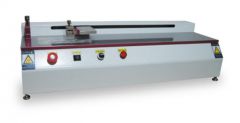 TT-1046 HORIZONTAL TENSILE TESTING MACHINETT-1046 HORIZONTAL TENSILE TESTING MACHINE KEY SPECIFICATION: CAPACITY: 500N DISPLAY: COMPUTER DISPLAY FORCE RESOLUTION: 1/100,000 FORCE ACCURACY: ≤+/-0.5% STROKE RANGE: 600mm STROKE RESOLUTION: 0.001mm TEST SPEED: 0.001-500mm/MIN CAN SET ON DISPLAY, WITH UP & DOWN FAST ADJUSTMENT BUTTON OF GRIPS FORCE UNIT SWITCH: KGF, N, IBF, G, TON, MPA STOP MODE: OVERLOAD STOP, EMERGENCY STOP BUTTON. SPECIMEN DAMAGE AUTOMATIC STOP MACHINE DRIVE: SERVO MOTOR DRIVE, SYNCHRONOUS WHEEL AND PRECISION BALL SCREW DRIVE POWER SUPPLY: AC 220V 50/60Hz 10A DIMENSIONS: 800 X 400 X 500mm WEIGHT: 50KG QUANTITY: 1 Learn More
TT-1046 HORIZONTAL TENSILE TESTING MACHINETT-1046 HORIZONTAL TENSILE TESTING MACHINE KEY SPECIFICATION: CAPACITY: 500N DISPLAY: COMPUTER DISPLAY FORCE RESOLUTION: 1/100,000 FORCE ACCURACY: ≤+/-0.5% STROKE RANGE: 600mm STROKE RESOLUTION: 0.001mm TEST SPEED: 0.001-500mm/MIN CAN SET ON DISPLAY, WITH UP & DOWN FAST ADJUSTMENT BUTTON OF GRIPS FORCE UNIT SWITCH: KGF, N, IBF, G, TON, MPA STOP MODE: OVERLOAD STOP, EMERGENCY STOP BUTTON. SPECIMEN DAMAGE AUTOMATIC STOP MACHINE DRIVE: SERVO MOTOR DRIVE, SYNCHRONOUS WHEEL AND PRECISION BALL SCREW DRIVE POWER SUPPLY: AC 220V 50/60Hz 10A DIMENSIONS: 800 X 400 X 500mm WEIGHT: 50KG QUANTITY: 1 Learn More -
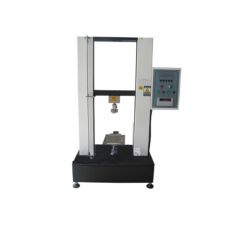 TT-1045 ELECTROMECHANICAL UNIVERSAL TESTING MACHINETT-1045 ELECTROMECHANICAL UNIVERSAL TESTING MACHINE TENSILE TESTING EQUIPMENT KEY SPECIFICATIONS: MAX. CAPACITY: 10N, 20N, 50N, 100N, 200N, 500N, 1KN, 2KN, 5KN,10KN,20KN DISPLAY: LCA MODE FORCE RESOLUTION: 1/100,000 FORCE ACCURACY: ≤+/-0.5% STROKE RESOLUTION: 0.5mm TEST SPEED: 1-500mm/MIN, CAN SET WITH UP & DOWN FAST ADJUSTMENT BUTTON OF GRIPS FORCE UNIT SWITCH: KGF, N, IBF, G, TON, MPA MACHINE DRIVE: MOTOR DRIVE DIMENSIONS: 720 X 620 X 1400mm (W X D X H) WEIGHT: 150KG STANDARD ACCESSORIES: 1 SET OF GRIP QUANTITY: 1 Learn More
TT-1045 ELECTROMECHANICAL UNIVERSAL TESTING MACHINETT-1045 ELECTROMECHANICAL UNIVERSAL TESTING MACHINE TENSILE TESTING EQUIPMENT KEY SPECIFICATIONS: MAX. CAPACITY: 10N, 20N, 50N, 100N, 200N, 500N, 1KN, 2KN, 5KN,10KN,20KN DISPLAY: LCA MODE FORCE RESOLUTION: 1/100,000 FORCE ACCURACY: ≤+/-0.5% STROKE RESOLUTION: 0.5mm TEST SPEED: 1-500mm/MIN, CAN SET WITH UP & DOWN FAST ADJUSTMENT BUTTON OF GRIPS FORCE UNIT SWITCH: KGF, N, IBF, G, TON, MPA MACHINE DRIVE: MOTOR DRIVE DIMENSIONS: 720 X 620 X 1400mm (W X D X H) WEIGHT: 150KG STANDARD ACCESSORIES: 1 SET OF GRIP QUANTITY: 1 Learn More -
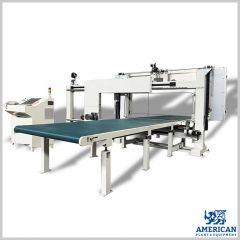 TT-1002 CNC DUAL FAST WIRE (HORIZONTAL & VERTICAL) CONTOUR CUTTER, CUT SPEED 10 METERS PER MINUTETT-1002 CNC DUAL FAST WIRE (HORIZONTAL & VERTICAL) CONTOUR CUTTER, CUT SPEED 10 METERS PER MINUTE MAXIMUM BUN SIZE: LENGTH 3000mm x WIDTH 2200mm x HEIGHT 1300mm MAIN FEATURES OF CONTOUR CUTTER: 1. ELIMINATES THE NEED TO MAKE, REPAIR AND STORE TEMPLATES; 2. INTEGRATED DESIGN & CUTTING PROGRAM. JUST DESIGN AND CUT; 3. COST SAVINGS BY AUTOMATICALLY ARRANGING THE PRODUCT (NESTING OF SHAPES TO MAXIMIZE MATERIAL USAGE) 4. SUPPORTS NUMERIC INSTRUMENTS; 5. HIGHER MATERIAL UTILIZATION RESULTING FROM COMPUTER AIDED NESTING OF SHAPES; 6. CUT SPEED CAN BE SET TO ARRIVE AT THE BEST CUT SPEED FOR DIFFERENT FOAMS; 7. CAN PRE-CUT ON THE COMPUTER TO CHECK CUTTING COURSE; Learn More
TT-1002 CNC DUAL FAST WIRE (HORIZONTAL & VERTICAL) CONTOUR CUTTER, CUT SPEED 10 METERS PER MINUTETT-1002 CNC DUAL FAST WIRE (HORIZONTAL & VERTICAL) CONTOUR CUTTER, CUT SPEED 10 METERS PER MINUTE MAXIMUM BUN SIZE: LENGTH 3000mm x WIDTH 2200mm x HEIGHT 1300mm MAIN FEATURES OF CONTOUR CUTTER: 1. ELIMINATES THE NEED TO MAKE, REPAIR AND STORE TEMPLATES; 2. INTEGRATED DESIGN & CUTTING PROGRAM. JUST DESIGN AND CUT; 3. COST SAVINGS BY AUTOMATICALLY ARRANGING THE PRODUCT (NESTING OF SHAPES TO MAXIMIZE MATERIAL USAGE) 4. SUPPORTS NUMERIC INSTRUMENTS; 5. HIGHER MATERIAL UTILIZATION RESULTING FROM COMPUTER AIDED NESTING OF SHAPES; 6. CUT SPEED CAN BE SET TO ARRIVE AT THE BEST CUT SPEED FOR DIFFERENT FOAMS; 7. CAN PRE-CUT ON THE COMPUTER TO CHECK CUTTING COURSE; Learn More -
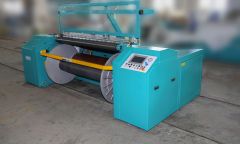 V-2005 WARPER AND CREEL FOR DENIM YARNS WITH 48 BEAMS; 1800mm WIDTH X 1400mm DIAMETERV-2005 WARPER AND CREEL FOR DENIM YARNS WITH 48 BEAMS; 1800mm WIDTH X 1400mm DIAMETER MAXIMUM WARPING SPEED: 1000 METERS PER MINUTE WARP DENSITY: 0.3 TO 0.65 G/cm3; BRAKE SYSTEM: PNEUMATIC-HYDRAULIC CLAMP-BRAKES ON GUIDE ROLLER, WARPING BEAM, PRESS ROLLER; BRAKING DISTANCE: ≤4M (AT SPEED OF 500 METERS PER MINUTE); LENGTH MEASURING: LENGTH MEASURING ON PRESSURE ROLLER WHEN WORKING, LENGTH MEASURING ON WARPING BEAM WHEN PRESS ROLLER BACKWARDS; LENGTH MEASURING ACCURACY: ±0.1%; PRESS METHOD: CYLINDER PUSHES PRESS ROLLER GIVING PARALLEL PRESSURE ALONG THE INCLINED LINEAR GUIDE, PNEUMATIC DISC OFFERS AUXILIARY DAMPING PRESSURE; EXPANSION REED TYPE: W SHAPE, MOVABLE UP AND DOWN, LEFT AND RIGHT; REED TRAVERSE RANGE: 0 TO 40mm ADJUSTABLE; REED TRAVERSE ADJUSTMENT: MANUALLY; REED TRAVERSE FREQUENCY: 24 CYCLES PER MINUTE; EXPANSION REED STRETCH METHOD: ELECTRICAL; REED CENTERING METHOD: ELECTRICAL; BEAM CLAMP: PNEUMATIC; PRESS ROLLER CENTERING: ELECTRICAL; WORKSTATION: TOUCH SCREEN, BUTTONS ON SAFETY BAR. QUANTITY: 1 SET SHIPPING NOTICE: 1 40FT CONTAINER FOR WARPER AND CREEL 1 40FT CONTAINER FOR 48 BEAMS TIME TO BUILD THE MACHINE: 100 DAYS Learn More
V-2005 WARPER AND CREEL FOR DENIM YARNS WITH 48 BEAMS; 1800mm WIDTH X 1400mm DIAMETERV-2005 WARPER AND CREEL FOR DENIM YARNS WITH 48 BEAMS; 1800mm WIDTH X 1400mm DIAMETER MAXIMUM WARPING SPEED: 1000 METERS PER MINUTE WARP DENSITY: 0.3 TO 0.65 G/cm3; BRAKE SYSTEM: PNEUMATIC-HYDRAULIC CLAMP-BRAKES ON GUIDE ROLLER, WARPING BEAM, PRESS ROLLER; BRAKING DISTANCE: ≤4M (AT SPEED OF 500 METERS PER MINUTE); LENGTH MEASURING: LENGTH MEASURING ON PRESSURE ROLLER WHEN WORKING, LENGTH MEASURING ON WARPING BEAM WHEN PRESS ROLLER BACKWARDS; LENGTH MEASURING ACCURACY: ±0.1%; PRESS METHOD: CYLINDER PUSHES PRESS ROLLER GIVING PARALLEL PRESSURE ALONG THE INCLINED LINEAR GUIDE, PNEUMATIC DISC OFFERS AUXILIARY DAMPING PRESSURE; EXPANSION REED TYPE: W SHAPE, MOVABLE UP AND DOWN, LEFT AND RIGHT; REED TRAVERSE RANGE: 0 TO 40mm ADJUSTABLE; REED TRAVERSE ADJUSTMENT: MANUALLY; REED TRAVERSE FREQUENCY: 24 CYCLES PER MINUTE; EXPANSION REED STRETCH METHOD: ELECTRICAL; REED CENTERING METHOD: ELECTRICAL; BEAM CLAMP: PNEUMATIC; PRESS ROLLER CENTERING: ELECTRICAL; WORKSTATION: TOUCH SCREEN, BUTTONS ON SAFETY BAR. QUANTITY: 1 SET SHIPPING NOTICE: 1 40FT CONTAINER FOR WARPER AND CREEL 1 40FT CONTAINER FOR 48 BEAMS TIME TO BUILD THE MACHINE: 100 DAYS Learn More -
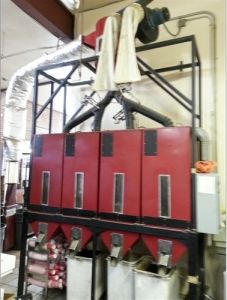 P-6603 SILOS ROASTED COFFEE STORAGE (STONER FED)
P-6603 SILOS ROASTED COFFEE STORAGE (STONER FED)P-6603 SILOS ROASTED COFFEE STORAGE (STONER FED)
THIS UNIT NEEDS TO BE REMOVED TO MAKE ROOM FOR BIG WALK-IN COOLER - AND IT CAN BE CHANGED RADICALLY TO FIT MOST ANY SITUATION. THE ACTUAL DE-STONER IS SITTING NEXT TO THE COOLER ON A 90 KILO PROBAT (ALTHOUGH THIS STONER/STORAGE SILO IS NOT LIMITED TO ANY SIZE AS THE STONER DOES NOT KNOW HOW BIG THE COOLER - IT ONLY KNOWS TO KEEP GOING TILL IT IS EMPTY.
STONER LIFTS COFFEE UP TO A SURGE HOPPER ABOVE - THEN GRAVITY FEEDS DOWN TO THE BIN THAT YOU TOLD IT TO GO . . . HOWEVER, THERE ARE SEVERAL OPTIONS ON HOW SUCH A SILO GETS LOADED - EVERYTHING FROM A SUCTION WAND TO OTHER CONFIGURATIONS OF THE GRAVITY ONE PICTURED . . . AS THIS IS A DISCUSSION TOPIC. THE TOP SECTION STANDS ALONE AND CAN EASILY BE REMOVED. THE ACTUAL STORAGE SILOS STAND ALONE AND THEY CAN BE EASILY REMOVED - OR EVEN BE MADE TALLER SHORTER TO FIT YOUR BUILDING. THEN THE BASE CAN BE ALTERED ACCORDINGLY. NOTICE THE CONTROL BOX ON THE LEFT SIDE - THAT IS 21 INCHES WIDE X 24 INCHES TALL AND 10 INCHES DEEP AND THAT CAN BE MOUNTED ON ANY WALL OR RIGHT WHERE IT IS . . . TOTALLY MOVABLE.
92.5 INCHES WIDE - THAT IS JUST SHORT OF 8 FEET OVERALL LENGTH.
8 FEET TALL FOR THE MAIN STORAGE PLUS THE STUFF ON TOP THAT MAY END UP BEING CHANGED.
36 INCHES WIDE ON THE STAND - BUT ACTUAL STORAGE IS 32 INCHES
19.5 CUBIC FEET OR 400 POUNDS ROASTED COFFEE
CAN BE USED FOR GREEN COFFEE - 850 POUNDS+
YOU CAN INSTALL ANY SPACE SAVING LOADING BLOWER, VACUUM OR EVEN AUGAR . . . GREEN OR ROASTED WHOLE BEAN
BASICALLY THERE ARE SO MANY CONFIGURATIONS OR WAYS TO USE THIS UNIT - IT IS JUST GREAT TO FIND SOMETHING SO WELL PRESERVED, AS THIS HAS BEEN SITTING UNUSED FOR AT LEAST 15 YEARS EVEN THOUGH THE ACTUAL COFFEE OPERATION IS VERY ACTIVE - JUST DID NOT USE THIS PARTICULAR CONFIGURATION.QUANTITY: 1
Learn More -
 TT-5081 PRODUCTION LINE FOR NEEDLE-PUNCHED NONWOVEN FABRICS, 50 Hz, YEAR 1992 TO 2024TT-5081 PRODUCTION LINE FOR NEEDLE-PUNCHED NONWOVEN FABRICS, 50 Hz, YEAR 1992 TO 2024 THE FOLLOWING WEIGHTS OF NONWOVEN FABRIC CAN BE MADE ON THE PRODUCTION LINE: 200 TO 1000 G/M² LINE EFFICIENCY: 300 KG/H FINAL WORKING WIDTH OF THE NONWOVEN FABRIC: 2500mm POWER SUPPLY: 400 V, 50 Hz, INSTALLED POWER: 62 KW THE LINE IS EQUIPPED WITH MODERN CONTROL IN CONTROL CABINETS NECESSARY AREA FOR THE ROPE: LENGTH: 17000mm, WIDTH: 10000mm, Learn More
TT-5081 PRODUCTION LINE FOR NEEDLE-PUNCHED NONWOVEN FABRICS, 50 Hz, YEAR 1992 TO 2024TT-5081 PRODUCTION LINE FOR NEEDLE-PUNCHED NONWOVEN FABRICS, 50 Hz, YEAR 1992 TO 2024 THE FOLLOWING WEIGHTS OF NONWOVEN FABRIC CAN BE MADE ON THE PRODUCTION LINE: 200 TO 1000 G/M² LINE EFFICIENCY: 300 KG/H FINAL WORKING WIDTH OF THE NONWOVEN FABRIC: 2500mm POWER SUPPLY: 400 V, 50 Hz, INSTALLED POWER: 62 KW THE LINE IS EQUIPPED WITH MODERN CONTROL IN CONTROL CABINETS NECESSARY AREA FOR THE ROPE: LENGTH: 17000mm, WIDTH: 10000mm, Learn More -
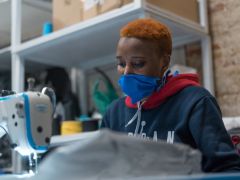 D-2388 What’s the Best Material for a Mask?
D-2388 What’s the Best Material for a Mask?Federal health officials have now recommended that we cover our faces with fabric during the coronavirus pandemic. But what material offers the most protection?
The Centers for Disease Control and Prevention has posted a no-sew mask pattern using a bandanna and a coffee filter as well as a video on making masks using rubber bands and folded fabrics found at home.
While a simple face covering can reduce the spread of coronavirus by blocking outgoing germs from coughs or sneezes of an infected person, experts say there is more variation in how much homemade masks might protect the wearer from incoming germs, depending on the fit and quality of the material used.
Scientists around the country have taken it upon themselves to identify everyday materials that do a better job of filtering microscopic particles. In recent tests, HEPA furnace filters scored well, as did vacuum cleaner bags, layers of 600-count pillowcases and fabric similar to flannel pajamas. Stacked coffee filters had medium scores. Scarves and bandanna material had the lowest scores, but still captured a small percentage of particles.
If you don’t have any of the materials that were tested, a simple light test can help you decide whether a fabric is a good candidate for a mask.
“Hold it up to a bright light,” said Dr. Scott Segal, chairman of anesthesiology at Wake Forest Baptist Health who recently studied homemade masks. “If light passes really easily through the fibers and you can almost see the fibers, it’s not a good fabric. If it’s a denser weave of thicker material and light doesn’t pass through it as much, that’s the material you want to use.”
Researchers say it’s important to remember that lab studies are conducted under perfect conditions with no leaks or gaps in the mask, but the test methods give us a way to compare materials. And while the degree of filtration for some homemade masks seems low, most of us — who are staying home and practicing social distancing in public — don’t need the high level of protection required for medical workers. More important, any face covering is better than none, especially if worn by a person who has the virus but doesn’t know it.
The biggest challenge of choosing a homemade mask material is to find a fabric that is dense enough to capture viral particles, but breathable enough that we can actually wear it. Some items being touted online promise high filtration scores, but the material would be unwearable.
Dressing Up for Work … at Home
Yang Wang, an assistant professor of environmental engineering at Missouri University of Science and Technology, worked with his graduate students to study various combinations of layered materials — including both air filters and fabric. “You need something that is efficient for removing particles, but you also need to breathe,” said Dr. Wang, who last fall won an international award for aerosol research.To test everyday materials, scientists are using methods similar to those used to test medical masks, which everybody agrees should be saved for medical workers who are exposed to high doses of virus from seeing infected patients. The best medical mask — called the N95 respirator — filters out at least 95 percent of particles as small as 0.3 microns. By comparison, a typical surgical mask — made using a rectangular piece of pleated fabric with elastic ear loops — has a filtration efficiency ranging from 60 to 80 percent.
Dr. Wang’s group tested two types of air filters. An allergy-reduction HVAC filter worked the best, capturing 89 percent of particles with one layer and 94 percent with two layers. A furnace filter captured 75 percent with two layers, but required six layers to achieve 95 percent. To find a filter similar to those tested, look for a minimum efficiency reporting value (MERV) rating of 12 or higher or a microparticle performance rating of 1900 or higher.
The problem with air filters is that they potentially could shed small fibers that would be risky to inhale. So if you want to use a filter, you need to sandwich the filter between two layers of cotton fabric. Dr. Wang said one of his grad students made his own mask by following the instructions in the C.D.C. video, but adding several layers of filter material inside a bandanna.
Dr. Wang’s group also found that when certain common fabrics were used, two layers offered far less protection than four layers. A 600 thread count pillow case captured just 22 percent of particles when doubled, but four layers captured nearly 60 percent. A thick woolen yarn scarf filtered 21 percent of particles in two layers, and 48.8 percent in four layers. A 100 percent cotton bandanna did the worst, capturing only 18.2 percent when doubled, and just 19.5 percent in four layers.
The group also tested Brew Rite and Natural Brew basket-style coffee filters, which, when stacked in three layers, showed 40 to 50 percent filtration efficiency — but they were less breathable than other options.
If you are lucky enough to know a quilter, ask them to make you a mask. Tests performed at the Wake Forest Institute for Regenerative Medicine in Winston-Salem, N.C., showed good results for homemade masks using quilting fabric. Dr. Segal, of Wake Forest Baptist Health, who led the study, noted that quilters tend to use high-quality, high-thread count cotton. The best homemade masks in his study were as good as surgical masks or slightly better, testing in the range of 70 to 79 percent filtration. Homemade masks that used flimsier fabric tested as low as 1 percent filtration, Dr. Segal said.
The best-performing designs were a mask constructed of two layers of high-quality, heavyweight “quilter’s cotton,” a two-layer mask made with thick batik fabric, and a double-layer mask with an inner layer of flannel and outer layer of cotton.
Bonnie Browning, executive show director for the American Quilter’s Society, said that quilters prefer tightly woven cottons and batik fabrics that stand up over time. Ms. Browning said most sewing machines can handle only two layers of fabric when making a pleated mask, but someone who wanted four layers of protection could wear two masks at a time.
Ms. Browning said she recently reached out to quilters on Facebook and heard from 71 people who have made a combined total of nearly 15,000 masks. “We quilters are very much in the thick of what’s going on with this,” said Ms. Browning, who lives in Paducah, Ky. “One thing most of us have is a stash of fabric.”
People who don’t sew could try a folded origami mask, created by Jiangmei Wu, assistant professor of interior design at Indiana University. Ms. Wu, who is known for her breathtaking folded artwork, said she began designing a folded mask out of a medical and building material called Tyvek, as well as vacuum bags, after her brother in Hong Kong, where mask wearing is common, suggested it. (DuPont, the maker of Tyvek, said in a statement that Tyvek is intended for medical apparel, not masks.) The folded mask pattern is free online, as is a video demonstrating the folding process. In tests at Missouri University and University of Virginia, scientists found that vacuum bags removed between 60 percent and 87 percent of particles. But some brands of vacuum bags may contain fiberglass or are harder to breathe through than other materials, and shouldn’t be used. Ms. Wu used a bag by EnviroCare Technologies, which has said it does not use fiberglass in its paper and synthetic cloth bags.
“I wanted to create an alternative for people who don’t sew,” said Ms. Wu, who said she is talking to various groups to find other materials that will be effective in a folded mask. “Given the shortage of all kinds of materials, even vacuum bags might run out.”
The scientists who conducted the tests used a standard of 0.3 microns because that is the measure used by the National Institute for Occupational Safety and Health for medical masks.
Linsey Marr, a Virginia Tech aerosol scientist and an expert in the transmission of viruses, said the certification method for respirators and HEPA filters focuses on 0.3 microns because particles around that size are the hardest to catch. While it seems counterintuitive, particles smaller than 0.1 microns are actually easier to catch because they have a lot of random motion that makes them bump into the filter fibers, she said.
“Even though coronavirus is around 0.1 microns, it floats around in a wide range of sizes, from around 0.2 to several hundred microns, because people shed the virus in respiratory fluid droplets that also contain lots of salts and proteins and other things,” said Dr. Marr. “Even if the water in the droplets fully evaporates, there’s still a lot of salt and proteins and other gunk that stays behind as solid or gel-like material. I think 0.3 microns is still useful for guidance because the minimum filtration efficiency will be somewhere around this size, and it’s what NIOSH uses.”
Learn More -
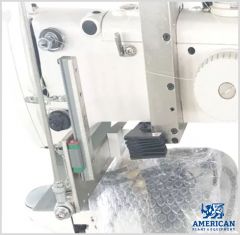 TT-1617 SPLIT HEAD PATTERN SEWING MACHINETT-1617 SPLIT HEAD PATTERN SEWING MACHINE SPECIFICATIONS SPLIT HEAD PATTERN SEWING MACHINE SPECIFICATIONS THE MAX. SEWING SPEED: 2000SPM HOOK: STANDARD HOOK THE MAX. FOOT LIFT: 115mm THE MAX.STITCH LENGTH: 12.70mm THE INSIDE WORKING LENGTH: 300mm NEEDLE: DPX17, #18 QUANTITY: 1 Learn More
TT-1617 SPLIT HEAD PATTERN SEWING MACHINETT-1617 SPLIT HEAD PATTERN SEWING MACHINE SPECIFICATIONS SPLIT HEAD PATTERN SEWING MACHINE SPECIFICATIONS THE MAX. SEWING SPEED: 2000SPM HOOK: STANDARD HOOK THE MAX. FOOT LIFT: 115mm THE MAX.STITCH LENGTH: 12.70mm THE INSIDE WORKING LENGTH: 300mm NEEDLE: DPX17, #18 QUANTITY: 1 Learn More -
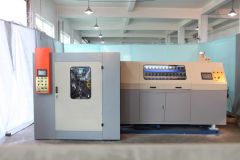 M-5128 FULL AUTOMATIC TRANSFER LINE FOR INNER SPRING UNITSREFERENCE NUMBER: M-5128 (121285KMN11UF) L FULL AUTOMATIC TRANSFER LINE FOR INNER SPRING UNITS FULL AUTOMATIC TRANSFER LINE FOR INNER SPRING UNITS MODEL: FC-90 PRODUCTION: 12 SPRING UNITS PER HOUR (SPRING UNIT SIZE 1.5 M X 2 M) SPRING TYPE: BONNELL SPRING DIAMETER: 67 TO 90mm STEEL WIRE DIAMETER: 1.9 TO 2.5mm SPRING HEIGHT (CAN BE CUSTOMIZED): 100 TO 180mm (<80mm NEEDS TO BE CUSTOMIZED) SPRING COILS: 4 TO 7 COILS HELICAL WIRE DIAMETER: 1.3 TO 1.4mm MAXIMUM SPRING UNIT WIDTH: 2050mm QUANTITY AVAILABLE: 1 Learn More
M-5128 FULL AUTOMATIC TRANSFER LINE FOR INNER SPRING UNITSREFERENCE NUMBER: M-5128 (121285KMN11UF) L FULL AUTOMATIC TRANSFER LINE FOR INNER SPRING UNITS FULL AUTOMATIC TRANSFER LINE FOR INNER SPRING UNITS MODEL: FC-90 PRODUCTION: 12 SPRING UNITS PER HOUR (SPRING UNIT SIZE 1.5 M X 2 M) SPRING TYPE: BONNELL SPRING DIAMETER: 67 TO 90mm STEEL WIRE DIAMETER: 1.9 TO 2.5mm SPRING HEIGHT (CAN BE CUSTOMIZED): 100 TO 180mm (<80mm NEEDS TO BE CUSTOMIZED) SPRING COILS: 4 TO 7 COILS HELICAL WIRE DIAMETER: 1.3 TO 1.4mm MAXIMUM SPRING UNIT WIDTH: 2050mm QUANTITY AVAILABLE: 1 Learn More
